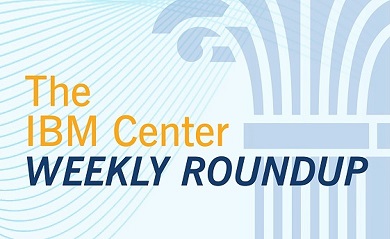
Weekly Roundup: May 24-28, 2021

How the TMF can enable broad improvements across government. The first two posts in this series were on enabling the TMF for success focused on how the fund could drive larger reforms across IT budgets, and how a strong link from the TMF to cybersecurity can lead to improved performance in the agency’s high-value assets (their most critical mission and business systems). This third post speaks to the long-term value of taking an enterprise approach for TMF investments, consistent with the OMB guidance. Linking the TMF to shared services continues a longstanding strategy to modernize governmentwide programs led by agencies that have the experience and expertise in specific domains.
Tech can help, but clearance reciprocity is a policy issue. The backlog of security clearance investigations has continued to drop from a 2018 high of 725,000 to a steady state inventory of 200,000, but agencies and contractors continue to struggle with reciprocity issues.
Army wants teleworkers to switch off smart IoT devices. The days of reminders of packages on the porch from a smartwatch or Netflix running as white noise from a smart TV in the background have come to an end -- at least for Army personnel working remotely. The Army announced it would require all of its military, civilian, and contractors to rid their telework environments of internet of things devices, such as smart TVs, speakers, and other networked devices with an "automated listening function."
The May 25 memo said the policy is an effort to "mitigate data leakage of official government information" and outline conditions so that Army personnel can "protect and safeguard DOD information" and systems.
After Colonial attack, TSA issues new cyber regs for pipelines. The Transportation Safety Administration on Thursday issued new security directives for pipeline owners and operators concerning how they respond and report cybersecurity incidents. The directives, according to a Department of Homeland Security statement emailed on Thursday morning, require companies to report "confirmed and potential" cybersecurity incidents to DHS's Cybersecurity and Infrastructure Security Agency. Companies also must designate a "cybersecurity coordinator" to be available at any time.
NITAAC releases long-awaited RFP for $50 billion CIO-SP4. The National Institute of Health's Information Technology Acquisition and Assessment Center (NITAAC) has released its long-awaited request for proposals for the CIO Solutions and Partners 4 (CIO-SP4) contract vehicle. CIO-SP4 is an indefinite-delivery, indefinite contract with a $50 billion ceiling designed to support IT solutions and services acquisition across 10 task areas, including cybersecurity, software development and IT services for biomedical research, health sciences and health care, among others. The new contract vehicle replaces CIO-SP3.
How Utah secures shared data. To combat the rising number of cyberattacks, Utah’s Department of Technology Services is encrypting the data it shares internally and externally with other agencies and private entities. DTS contracted with Virtru, an encryption company, about five years ago to shore up its enterprise cloud-based email system after finding the administrative tools in its previous solution to be problematic.
How to create buy-in for agile strategy.Agile strategy goes better when stakeholders understand the benefits, receive training and see successes celebrated, writes agile coach Andrew Romanukha. "Agile transformation is a group effort -- a continuous process that requires a comprehensive approach, involving everyone from top to bottom," he writes. The Enterprisers Project
Decisions need a clear decision-maker. Decision-making is more effective when the desired outcomes are clear and it's known who makes the final decision, write Karin Hurt and David Dye. "You also empower your people to be more influential because when they know who owns the decision, they also know how to share their information," they write. Let's Grow Leaders
What is noise, and why does it matter for strategy? Noise within organizations isn't just the literal sound levels, but also the variability in the information received, interpreted and acted upon by organizations and individuals. A book by Daniel Kahneman, Olivier Sibony and Cass Sunstein investigates the three main types of decision-making noise, discusses the disastrous effects of underestimating noise and offers a guide to improving "decision hygiene" at your organization. Strategy+Business
Hybrid work is about meeting psychological needs. Motivation remains important to employee productivity and job satisfaction regardless of where the work takes place, writes Susan Fowler. "Help them explore how working from home, office, or a hybrid design best fulfills their family values while still supporting coworkers (and enabling coworkers to support them)," she writes. SmartBrief/Leadership
Let's rethink strategy's relationship with culture. The quote "Culture eats strategy for breakfast" was never written by Peter Drucker, and it also underestimates the difficulty and importance of clear, meaningful strategy, writes Adam Bryant. He quotes executives from Disney, Twilio and Gridiron Capital on better ways to think about how culture and strategy support each other. Strategy+Business
Be clear about these 4 things when reopening offices. This article offers advice from Gartner experts on how and when employers should communicate back-to-office procedures, including vaccinations, safety and hybrid work requirements. Harvard Business Review
Next Week on The Business of Government Hour: Special Edition of The Business of Government Hour Leaders Speak on Managing Risk in Government. What is Enterprise Risk Management? What are some of the key risks facing government today? How has the managing and responding to risk evolved in U.S. federal agencies? Join host Michael Keegan as he explores these questions and more on a Special Edition of The Business of Government Hour – Leaders Speak on Managing Risk in Government.
Broadcast Schedule: The show airs Monday at 11 a.m., and Friday at 1 p.m. on Federal News Network 1500AM WFED





